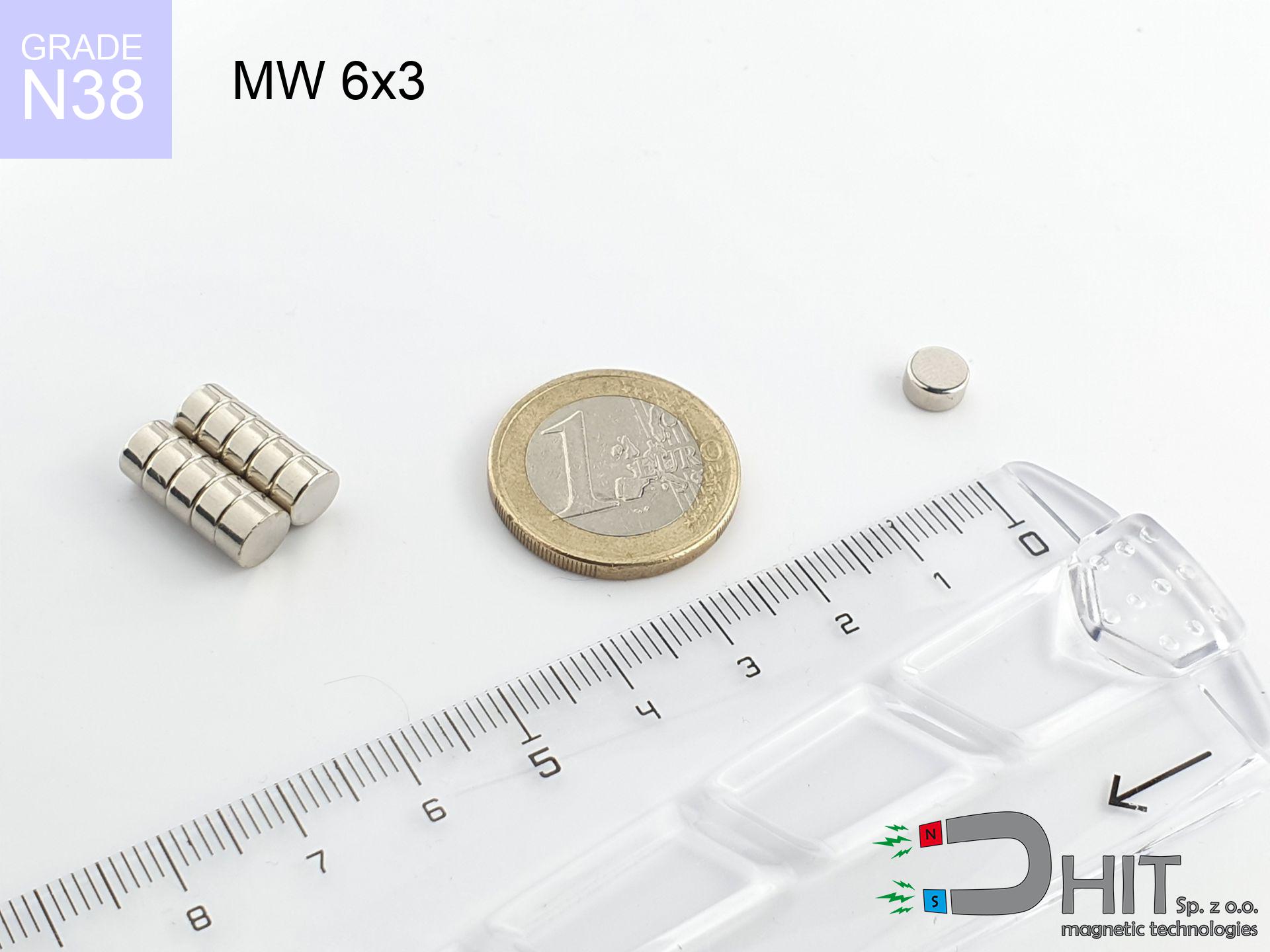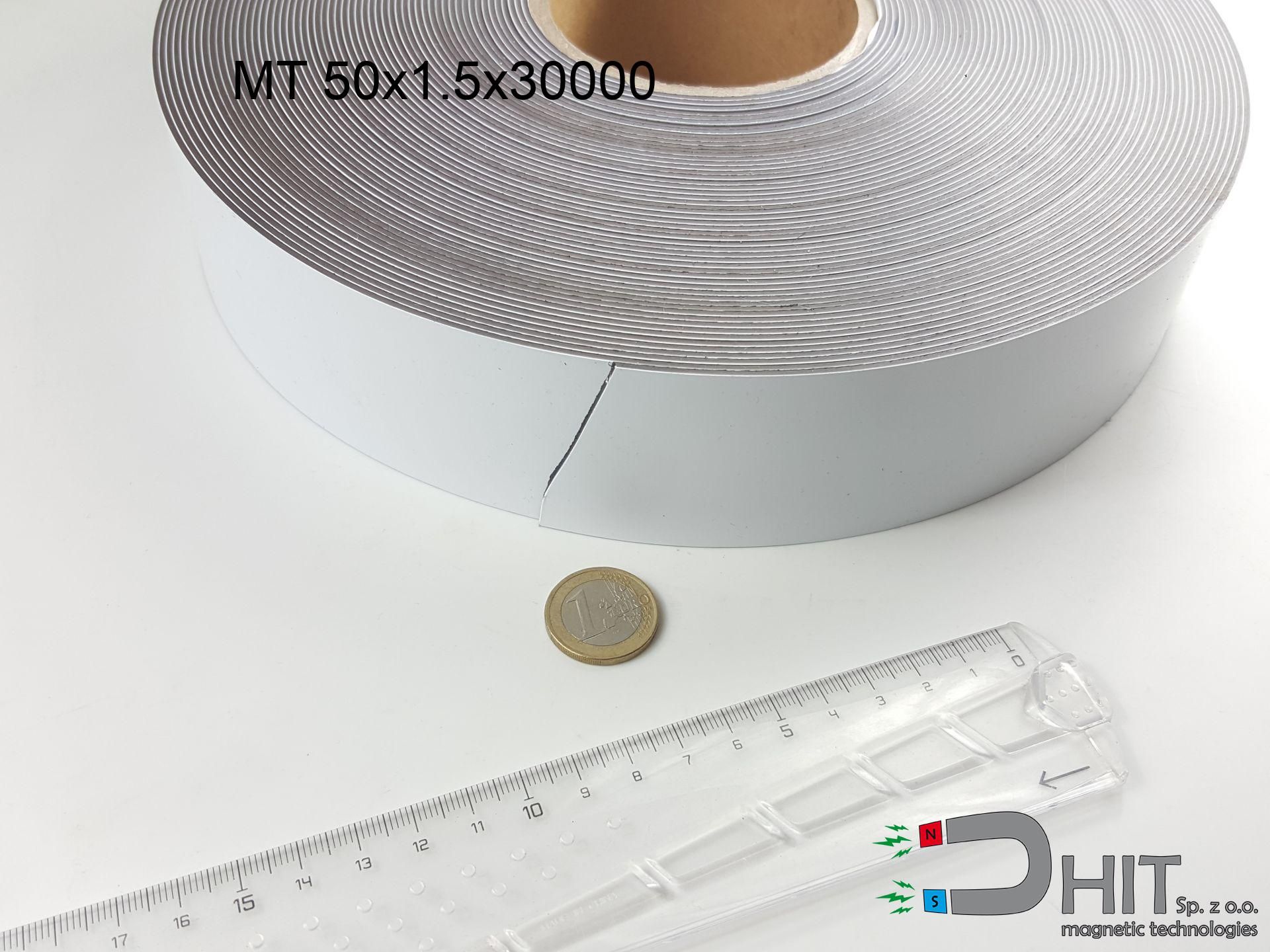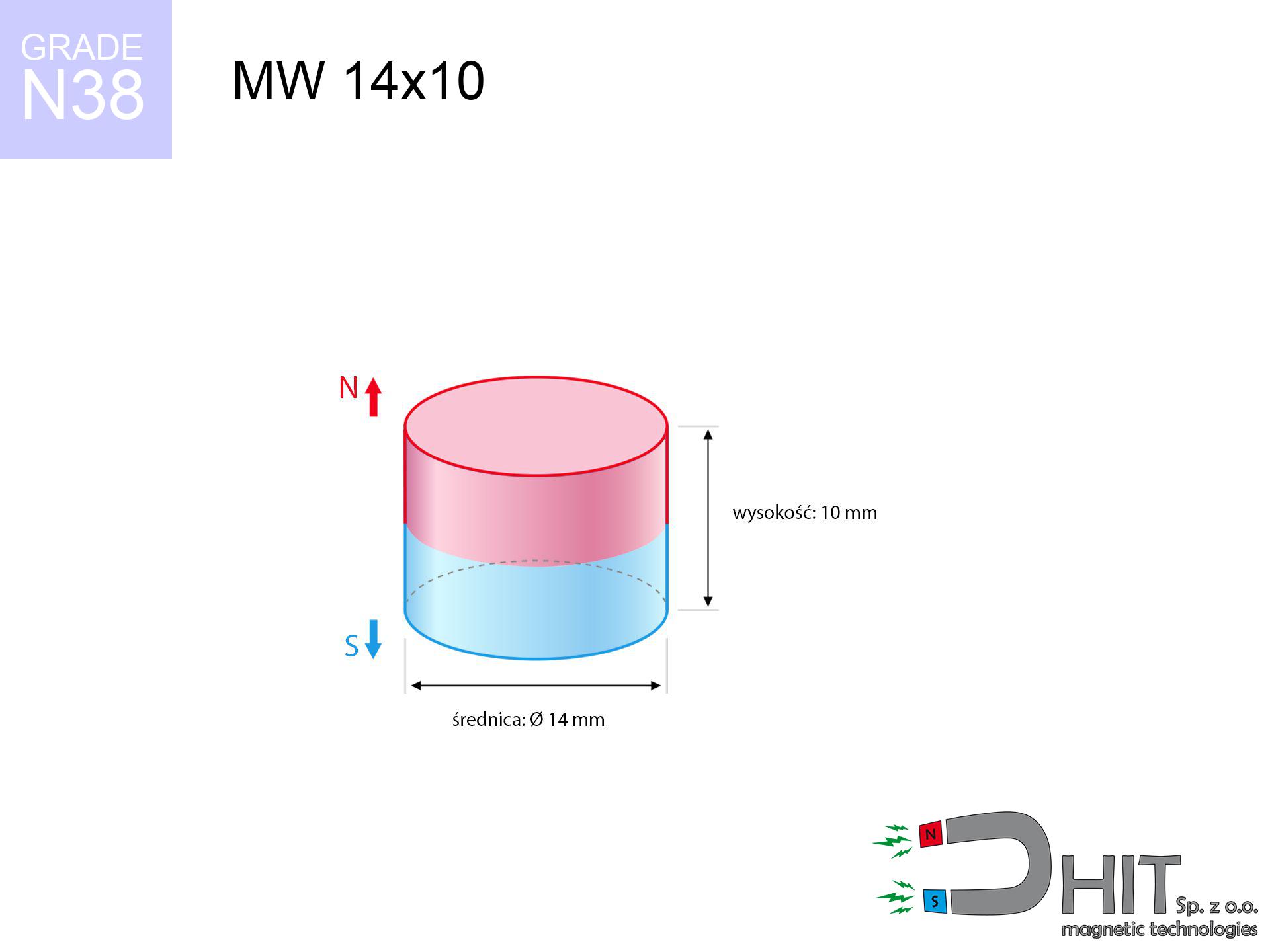MW 6x3 / N38 - cylindrical magnet
cylindrical magnet
Catalog no 010093
GTIN/EAN: 5906301810926
Diameter Ø
6 mm [±0,1 mm]
Height
3 mm [±0,1 mm]
Weight
0.64 g
Magnetization Direction
↑ axial
Load capacity
1.15 kg / 11.23 N
Magnetic Induction
437.58 mT / 4376 Gs
Coating
[NiCuNi] Nickel
0.381 ZŁ with VAT / pcs + price for transport
0.310 ZŁ net + 23% VAT / pcs
bulk discounts:
Need more?Not sure about your choice?
Call us
+48 888 99 98 98
or drop us a message via
form
through our site.
Parameters as well as shape of a magnet can be tested with our
magnetic mass calculator.
Orders placed before 14:00 will be shipped the same business day.
MW 6x3 / N38 - cylindrical magnet
Specification / characteristics MW 6x3 / N38 - cylindrical magnet
| properties | values |
|---|---|
| Cat. no. | 010093 |
| GTIN/EAN | 5906301810926 |
| Production/Distribution | Dhit sp. z o.o. |
| Country of origin | Poland / China / Germany |
| Customs code | 85059029 |
| Diameter Ø | 6 mm [±0,1 mm] |
| Height | 3 mm [±0,1 mm] |
| Weight | 0.64 g |
| Magnetization Direction | ↑ axial |
| Load capacity ~ ? | 1.15 kg / 11.23 N |
| Magnetic Induction ~ ? | 437.58 mT / 4376 Gs |
| Coating | [NiCuNi] Nickel |
| Manufacturing Tolerance | ±0.1 mm |
Magnetic properties of material N38
| properties | values | units |
|---|---|---|
| remenance Br [min. - max.] ? | 12.2-12.6 | kGs |
| remenance Br [min. - max.] ? | 1220-1260 | mT |
| coercivity bHc ? | 10.8-11.5 | kOe |
| coercivity bHc ? | 860-915 | kA/m |
| actual internal force iHc | ≥ 12 | kOe |
| actual internal force iHc | ≥ 955 | kA/m |
| energy density [min. - max.] ? | 36-38 | BH max MGOe |
| energy density [min. - max.] ? | 287-303 | BH max KJ/m |
| max. temperature ? | ≤ 80 | °C |
Physical properties of sintered neodymium magnets Nd2Fe14B at 20°C
| properties | values | units |
|---|---|---|
| Vickers hardness | ≥550 | Hv |
| Density | ≥7.4 | g/cm3 |
| Curie Temperature TC | 312 - 380 | °C |
| Curie Temperature TF | 593 - 716 | °F |
| Specific resistance | 150 | μΩ⋅cm |
| Bending strength | 250 | MPa |
| Compressive strength | 1000~1100 | MPa |
| Thermal expansion parallel (∥) to orientation (M) | (3-4) x 10-6 | °C-1 |
| Thermal expansion perpendicular (⊥) to orientation (M) | -(1-3) x 10-6 | °C-1 |
| Young's modulus | 1.7 x 104 | kg/mm² |
Technical modeling of the assembly - data
Presented values represent the result of a physical simulation. Values rely on models for the material Nd2Fe14B. Actual parameters may deviate from the simulation results. Treat these data as a supplementary guide during assembly planning.
MW 6x3 / N38
| Distance (mm) | Induction (Gauss) / mT | Pull Force (kg) | Risk Status |
|---|---|---|---|
| 0 mm |
4371 Gs
437.1 mT
|
1.15 kg / 1150.0 g
11.3 N
|
weak grip |
| 1 mm |
2999 Gs
299.9 mT
|
0.54 kg / 541.6 g
5.3 N
|
weak grip |
| 2 mm |
1877 Gs
187.7 mT
|
0.21 kg / 212.2 g
2.1 N
|
weak grip |
| 3 mm |
1161 Gs
116.1 mT
|
0.08 kg / 81.2 g
0.8 N
|
weak grip |
| 5 mm |
489 Gs
48.9 mT
|
0.01 kg / 14.4 g
0.1 N
|
weak grip |
| 10 mm |
103 Gs
10.3 mT
|
0.00 kg / 0.6 g
0.0 N
|
weak grip |
| 15 mm |
36 Gs
3.6 mT
|
0.00 kg / 0.1 g
0.0 N
|
weak grip |
| 20 mm |
17 Gs
1.7 mT
|
0.00 kg / 0.0 g
0.0 N
|
weak grip |
| 30 mm |
5 Gs
0.5 mT
|
0.00 kg / 0.0 g
0.0 N
|
weak grip |
| 50 mm |
1 Gs
0.1 mT
|
0.00 kg / 0.0 g
0.0 N
|
weak grip |
MW 6x3 / N38
| Distance (mm) | Friction coefficient | Pull Force (kg) |
|---|---|---|
| 0 mm | Stal (~0.2) |
0.23 kg / 230.0 g
2.3 N
|
| 1 mm | Stal (~0.2) |
0.11 kg / 108.0 g
1.1 N
|
| 2 mm | Stal (~0.2) |
0.04 kg / 42.0 g
0.4 N
|
| 3 mm | Stal (~0.2) |
0.02 kg / 16.0 g
0.2 N
|
| 5 mm | Stal (~0.2) |
0.00 kg / 2.0 g
0.0 N
|
| 10 mm | Stal (~0.2) |
0.00 kg / 0.0 g
0.0 N
|
| 15 mm | Stal (~0.2) |
0.00 kg / 0.0 g
0.0 N
|
| 20 mm | Stal (~0.2) |
0.00 kg / 0.0 g
0.0 N
|
| 30 mm | Stal (~0.2) |
0.00 kg / 0.0 g
0.0 N
|
| 50 mm | Stal (~0.2) |
0.00 kg / 0.0 g
0.0 N
|
MW 6x3 / N38
| Surface type | Friction coefficient / % Mocy | Max load (kg) |
|---|---|---|
| Raw steel |
µ = 0.3
30% Nominalnej Siły
|
0.35 kg / 345.0 g
3.4 N
|
| Painted steel (standard) |
µ = 0.2
20% Nominalnej Siły
|
0.23 kg / 230.0 g
2.3 N
|
| Oily/slippery steel |
µ = 0.1
10% Nominalnej Siły
|
0.11 kg / 115.0 g
1.1 N
|
| Magnet with anti-slip rubber |
µ = 0.5
50% Nominalnej Siły
|
0.58 kg / 575.0 g
5.6 N
|
MW 6x3 / N38
| Steel thickness (mm) | % power | Real pull force (kg) |
|---|---|---|
| 0.5 mm |
|
0.11 kg / 115.0 g
1.1 N
|
| 1 mm |
|
0.29 kg / 287.5 g
2.8 N
|
| 2 mm |
|
0.58 kg / 575.0 g
5.6 N
|
| 5 mm |
|
1.15 kg / 1150.0 g
11.3 N
|
| 10 mm |
|
1.15 kg / 1150.0 g
11.3 N
|
MW 6x3 / N38
| Ambient temp. (°C) | Power loss | Remaining pull | Status |
|---|---|---|---|
| 20 °C | 0.0% |
1.15 kg / 1150.0 g
11.3 N
|
OK |
| 40 °C | -2.2% |
1.12 kg / 1124.7 g
11.0 N
|
OK |
| 60 °C | -4.4% |
1.10 kg / 1099.4 g
10.8 N
|
|
| 80 °C | -6.6% |
1.07 kg / 1074.1 g
10.5 N
|
|
| 100 °C | -28.8% |
0.82 kg / 818.8 g
8.0 N
|
MW 6x3 / N38
| Gap (mm) | Attraction (kg) (N-S) | Repulsion (kg) (N-N) |
|---|---|---|
| 0 mm |
3.33 kg / 3330 g
32.7 N
5 527 Gs
|
N/A |
| 1 mm |
2.37 kg / 2371 g
23.3 N
7 376 Gs
|
2.13 kg / 2134 g
20.9 N
~0 Gs
|
| 2 mm |
1.57 kg / 1568 g
15.4 N
5 999 Gs
|
1.41 kg / 1411 g
13.8 N
~0 Gs
|
| 3 mm |
0.99 kg / 992 g
9.7 N
4 772 Gs
|
0.89 kg / 893 g
8.8 N
~0 Gs
|
| 5 mm |
0.38 kg / 379 g
3.7 N
2 948 Gs
|
0.34 kg / 341 g
3.3 N
~0 Gs
|
| 10 mm |
0.04 kg / 42 g
0.4 N
978 Gs
|
0.04 kg / 37 g
0.4 N
~0 Gs
|
| 20 mm |
0.00 kg / 2 g
0.0 N
205 Gs
|
0.00 kg / 0 g
0.0 N
~0 Gs
|
| 50 mm |
0.00 kg / 0 g
0.0 N
18 Gs
|
0.00 kg / 0 g
0.0 N
~0 Gs
|
MW 6x3 / N38
| Object / Device | Limit (Gauss) / mT | Safe distance |
|---|---|---|
| Pacemaker | 5 Gs (0.5 mT) | 3.5 cm |
| Hearing aid | 10 Gs (1.0 mT) | 2.5 cm |
| Timepiece | 20 Gs (2.0 mT) | 2.0 cm |
| Mobile device | 40 Gs (4.0 mT) | 1.5 cm |
| Car key | 50 Gs (5.0 mT) | 1.5 cm |
| Payment card | 400 Gs (40.0 mT) | 1.0 cm |
| HDD hard drive | 600 Gs (60.0 mT) | 0.5 cm |
MW 6x3 / N38
| Start from (mm) | Speed (km/h) | Energy (J) | Predicted outcome |
|---|---|---|---|
| 10 mm |
42.77 km/h
(11.88 m/s)
|
0.05 J | |
| 30 mm |
74.05 km/h
(20.57 m/s)
|
0.14 J | |
| 50 mm |
95.59 km/h
(26.55 m/s)
|
0.23 J | |
| 100 mm |
135.19 km/h
(37.55 m/s)
|
0.45 J |
MW 6x3 / N38
| Technical parameter | Value / Description |
|---|---|
| Coating type | [NiCuNi] Nickel |
| Layer structure | Nickel - Copper - Nickel |
| Layer thickness | 10-20 µm |
| Salt spray test (SST) ? | 24 h |
| Recommended environment | Indoors only (dry) |
MW 6x3 / N38
| Parameter | Value | SI Unit / Description |
|---|---|---|
| Magnetic Flux | 1 256 Mx | 12.6 µWb |
| Pc Coefficient | 0.59 | Low (Flat) |
MW 6x3 / N38
| Environment | Effective steel pull | Effect |
|---|---|---|
| Air (land) | 1.15 kg | Standard |
| Water (riverbed) |
1.32 kg
(+0.17 kg Buoyancy gain)
|
+14.5% |
1. Sliding resistance
*Note: On a vertical surface, the magnet holds merely ~20% of its nominal pull.
2. Steel saturation
*Thin steel (e.g. computer case) drastically weakens the holding force.
3. Power loss vs temp
*For standard magnets, the critical limit is 80°C.
4. Demagnetization curve and operating point (B-H)
chart generated for the permeance coefficient Pc (Permeance Coefficient) = 0.59
The chart above illustrates the magnetic characteristics of the material within the second quadrant of the hysteresis loop. The solid red line represents the demagnetization curve (material potential), while the dashed blue line is the load line based on the magnet's geometry. The Pc (Permeance Coefficient), also known as the load line slope, is a dimensionless value that describes the relationship between the magnet's shape and its magnetic stability. The intersection of these two lines (the black dot) is the operating point — it determines the actual magnetic flux density generated by the magnet in this specific configuration. A higher Pc value means the magnet is more 'slender' (tall relative to its area), resulting in a higher operating point and better resistance to irreversible demagnetization caused by external fields or temperature. A value of 0.42 is relatively low (typical for flat magnets), meaning the operating point is closer to the 'knee' of the curve — caution is advised when operating at temperatures near the maximum limit to avoid strength loss.
Material specification
| iron (Fe) | 64% – 68% |
| neodymium (Nd) | 29% – 32% |
| boron (B) | 1.1% – 1.2% |
| dysprosium (Dy) | 0.5% – 2.0% |
| coating (Ni-Cu-Ni) | < 0.05% |
Environmental data
| recyclability (EoL) | 100% |
| recycled raw materials | ~10% (pre-cons) |
| carbon footprint | low / zredukowany |
| waste code (EWC) | 16 02 16 |
Other deals
Pros and cons of Nd2Fe14B magnets.
Strengths
- They have constant strength, and over more than 10 years their performance decreases symbolically – ~1% (in testing),
- They possess excellent resistance to magnetic field loss due to external magnetic sources,
- In other words, due to the reflective surface of silver, the element gains visual value,
- The surface of neodymium magnets generates a powerful magnetic field – this is a distinguishing feature,
- Neodymium magnets are characterized by very high magnetic induction on the magnet surface and can function (depending on the form) even at a temperature of 230°C or more...
- Possibility of precise forming and adjusting to individual applications,
- Universal use in future technologies – they are utilized in HDD drives, motor assemblies, medical equipment, and other advanced devices.
- Thanks to their power density, small magnets offer high operating force, occupying minimum space,
Disadvantages
- At strong impacts they can crack, therefore we recommend placing them in steel cases. A metal housing provides additional protection against damage, as well as increases the magnet's durability.
- When exposed to high temperature, neodymium magnets experience a drop in power. Often, when the temperature exceeds 80°C, their strength decreases (depending on the size and shape of the magnet). For those who need magnets for extreme conditions, we offer [AH] versions withstanding up to 230°C
- Magnets exposed to a humid environment can rust. Therefore when using outdoors, we suggest using water-impermeable magnets made of rubber, plastic or other material protecting against moisture
- Limited ability of creating threads in the magnet and complicated shapes - recommended is a housing - magnetic holder.
- Possible danger resulting from small fragments of magnets are risky, in case of ingestion, which is particularly important in the context of child health protection. Additionally, tiny parts of these devices are able to be problematic in diagnostics medical after entering the body.
- With budget limitations the cost of neodymium magnets is economically unviable,
Holding force characteristics
Optimal lifting capacity of a neodymium magnet – what affects it?
- on a block made of structural steel, effectively closing the magnetic flux
- possessing a thickness of minimum 10 mm to avoid saturation
- characterized by smoothness
- without any clearance between the magnet and steel
- for force acting at a right angle (pull-off, not shear)
- at conditions approx. 20°C
Key elements affecting lifting force
- Clearance – the presence of any layer (rust, dirt, air) interrupts the magnetic circuit, which lowers capacity rapidly (even by 50% at 0.5 mm).
- Load vector – highest force is reached only during perpendicular pulling. The force required to slide of the magnet along the plate is standardly several times lower (approx. 1/5 of the lifting capacity).
- Metal thickness – the thinner the sheet, the weaker the hold. Part of the magnetic field passes through the material instead of converting into lifting capacity.
- Chemical composition of the base – low-carbon steel gives the best results. Alloy admixtures decrease magnetic properties and lifting capacity.
- Base smoothness – the more even the surface, the larger the contact zone and higher the lifting capacity. Unevenness creates an air distance.
- Thermal factor – high temperature reduces magnetic field. Too high temperature can permanently damage the magnet.
Holding force was checked on the plate surface of 20 mm thickness, when a perpendicular force was applied, whereas under attempts to slide the magnet the holding force is lower. In addition, even a small distance between the magnet’s surface and the plate decreases the load capacity.
Magnetic media
Avoid bringing magnets near a purse, laptop, or screen. The magnetic field can destroy these devices and wipe information from cards.
Phone sensors
A strong magnetic field interferes with the functioning of magnetometers in smartphones and navigation systems. Do not bring magnets close to a device to prevent breaking the sensors.
Maximum temperature
Standard neodymium magnets (N-type) lose magnetization when the temperature exceeds 80°C. Damage is permanent.
Sensitization to coating
Nickel alert: The nickel-copper-nickel coating contains nickel. If redness happens, immediately stop handling magnets and wear gloves.
Health Danger
Medical warning: Strong magnets can turn off pacemakers and defibrillators. Stay away if you have electronic implants.
Do not give to children
These products are not toys. Eating several magnets can lead to them connecting inside the digestive tract, which poses a critical condition and necessitates urgent medical intervention.
Mechanical processing
Mechanical processing of NdFeB material carries a risk of fire risk. Magnetic powder reacts violently with oxygen and is hard to extinguish.
Hand protection
Pinching hazard: The pulling power is so immense that it can result in hematomas, pinching, and broken bones. Use thick gloves.
Magnets are brittle
Despite metallic appearance, neodymium is brittle and not impact-resistant. Do not hit, as the magnet may shatter into hazardous fragments.
Respect the power
Use magnets consciously. Their powerful strength can surprise even experienced users. Plan your moves and do not underestimate their power.





![SM 25x200 [2xM8] / N52 - magnetic separator SM 25x200 [2xM8] / N52 - magnetic separator](https://cdn3.dhit.pl/graphics/products/sm-25x200-2xm8-jas.jpg)



